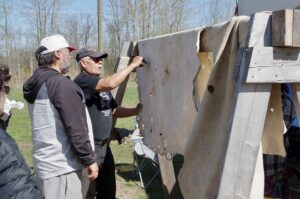Fort William First Nation’s 5th Annual Moose Hide Camp a success

By Rick Garrick
FORT WILLIAM — Fort William’s 5th Annual Moose Hide Camp was a success with more activities and participants over five days from May 9-13 at the CNRA Building in the community.
“The camp went very well, we’re going to end with a feast today,” says Shelby Gagnon, one of the workshop leaders and an Aroland citizen. “We’re smoking the hides right now, there’s one, two on the go, still some softening, we’re about to put up another one to smoke and some participants are going to leave with some deer hides that they’ve been working on all weekend.”
Fort William’s Travis McKay says there was a lot of teamwork and community during the camp, noting that he learned about the right type of punky wood to use for the hide smoking process, how to keep the “tools kind of dull”, and to keep asking questions.
“I like the reclaiming of our culture and bringing back some of this work that used to be done for thousands of years and the rarity of some of these products, the amount of work that goes into it makes it mean a little bit more,” McKay says. “I plan on trying my hand at a few deer hides with a couple of community members that also have a little bit of experience and we’ll see how far we get. I have some resources for information now. I hope I keep seeing this [camp] happen.”
Wiikwemkoong Unceded Territory’s Andrew Mandamin, who delivered a Bone Tool Making workshop on the second day of the camp, also enjoyed participating in different activities at the camp.
“I think this is the best we’ve had so far of all the hide camps here,” Mandamin says. “There was a big turnout, a lot of participation, a lot of young people participating — it’s good to see that they’re learning what our ancestors did years ago.”
Fort William Chief Michele Solomon and federal NDP leader Jagmeet Singh also visited the camp on the fifth day.
“He came to my office and we met briefly, and I asked him if he would like to join me to check out the moose hide tanning camp and he didn’t hesitate,” Solomon says. “He thought it was a really awesome event that community was coming together and he was asking people questions about the work that’s involved and he was very captivated, I would say. He was well received by the participants and we got to witness some of the [Anishinaabemowin] puppet show. They were at the point of smoking the hides so that was really wonderful to witness.”
Solomon says there were about 40 people at the camp for the opening day ceremony.
“And every day that you went by there, it didn’t matter what time it was, the parking lot was full of cars and overall it was a great turnout,” Solomon says.
Nate Johnson, one of the workshop leaders from Minnesota, says he was doing a brain-tanning deer hide workshop at the camp.
“We took four deer hides, we started yesterday and we scraped the hair off and we scraped a layer of skin called the grain layer beneath the hair — we want to make fuzzy brain-tanned buckskin,” Johnson says on the third day of the camp. “Today, we blended up some deer brains with water, we soaked the hides in the deer brains and water solution and wrung it out and did that two more times. This hide has been stretched on a frame and people are pushing on it with stakes to keep the fibres moving while it dries in the sun, and if we keep the fibres moving the whole time it’s drying, then we’ll get a nice soft hide.”
Johnson says the final step is smoking the hides with smouldering coals of punky wood.


